Charles Sturt University HRM523: Industrial Relations and Minimum Wage
VerifiedAdded on 2022/11/13
|8
|1836
|115
Report
AI Summary
This report provides an in-depth analysis of industrial relations, with a specific focus on the minimum wage case of 2019 in Australia. The study examines the complex relationships between employees, employers, trade unions, employer organizations, and the state. The report delves into the submissions made by the Australian Workers’ Union (AWU) and the NGO ACOSS, evaluating their positions on minimum wage and its impact on various sectors. It explores the application of industrial relations theories, including unitarism, pluralism, and radical approaches, to understand workplace dynamics. Furthermore, the report highlights the role of trade unions in resolving disputes, negotiating wages, and ensuring fair treatment of employees. The report also discusses the influence of minimum wage policies on employment, poverty, and the overall economic landscape. The conclusion summarizes the findings and emphasizes the significance of trade unions and minimum wage policies in shaping the industrial relations environment in Australia.
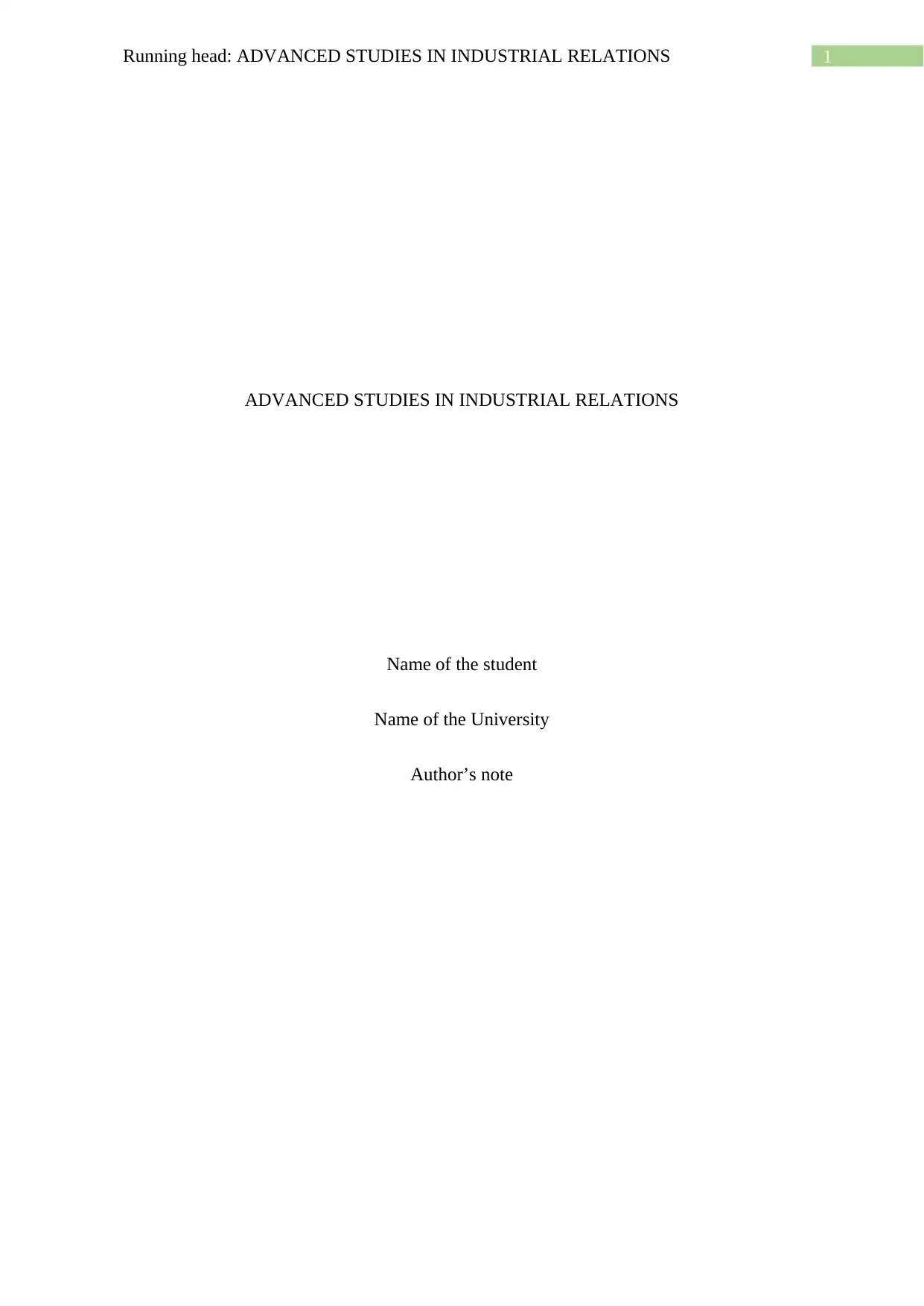
1Running head: ADVANCED STUDIES IN INDUSTRIAL RELATIONS
ADVANCED STUDIES IN INDUSTRIAL RELATIONS
Name of the student
Name of the University
Author’s note
ADVANCED STUDIES IN INDUSTRIAL RELATIONS
Name of the student
Name of the University
Author’s note
Paraphrase This Document
Need a fresh take? Get an instant paraphrase of this document with our AI Paraphraser
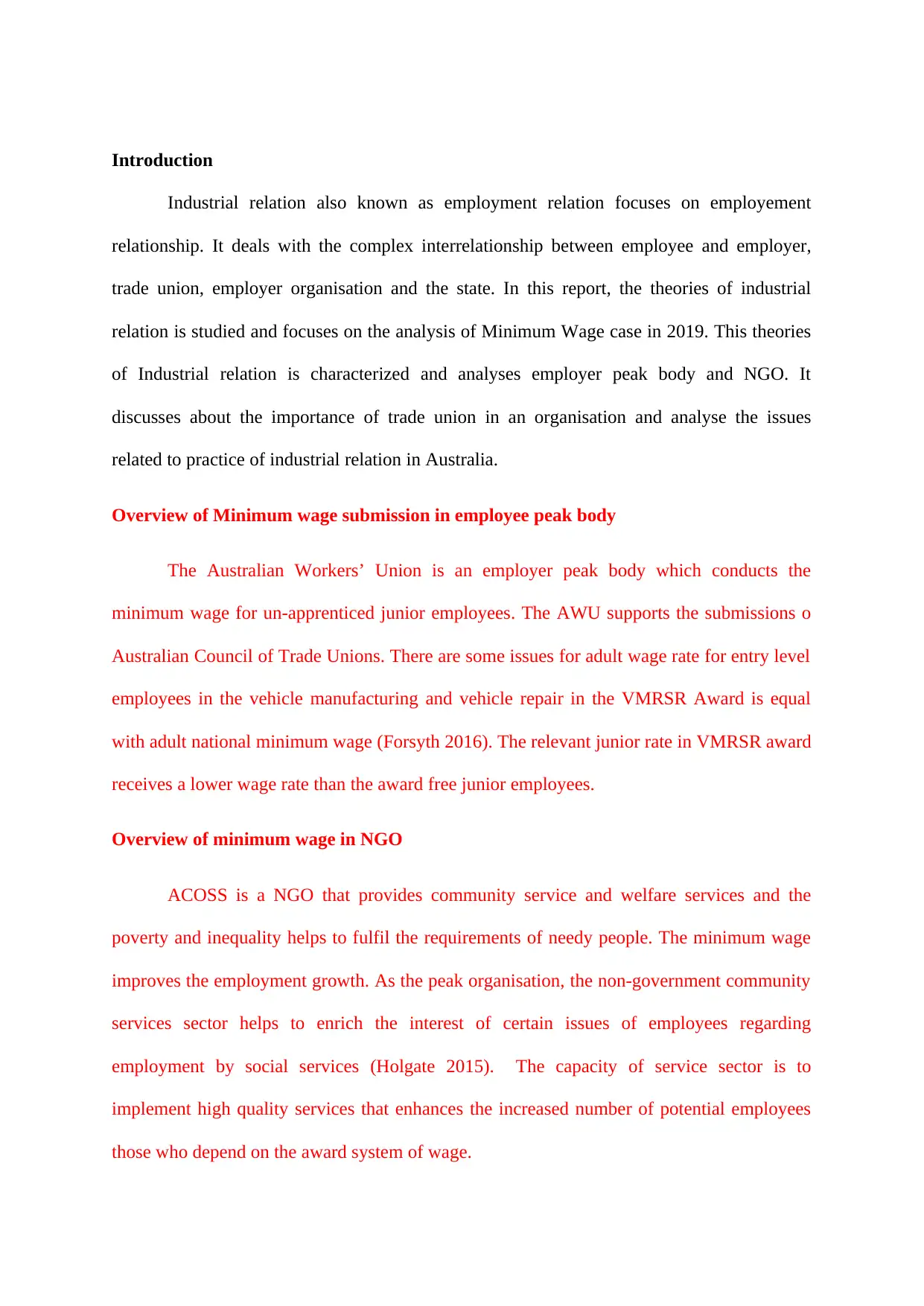
Introduction
Industrial relation also known as employment relation focuses on employement
relationship. It deals with the complex interrelationship between employee and employer,
trade union, employer organisation and the state. In this report, the theories of industrial
relation is studied and focuses on the analysis of Minimum Wage case in 2019. This theories
of Industrial relation is characterized and analyses employer peak body and NGO. It
discusses about the importance of trade union in an organisation and analyse the issues
related to practice of industrial relation in Australia.
Overview of Minimum wage submission in employee peak body
The Australian Workers’ Union is an employer peak body which conducts the
minimum wage for un-apprenticed junior employees. The AWU supports the submissions o
Australian Council of Trade Unions. There are some issues for adult wage rate for entry level
employees in the vehicle manufacturing and vehicle repair in the VMRSR Award is equal
with adult national minimum wage (Forsyth 2016). The relevant junior rate in VMRSR award
receives a lower wage rate than the award free junior employees.
Overview of minimum wage in NGO
ACOSS is a NGO that provides community service and welfare services and the
poverty and inequality helps to fulfil the requirements of needy people. The minimum wage
improves the employment growth. As the peak organisation, the non-government community
services sector helps to enrich the interest of certain issues of employees regarding
employment by social services (Holgate 2015). The capacity of service sector is to
implement high quality services that enhances the increased number of potential employees
those who depend on the award system of wage.
Industrial relation also known as employment relation focuses on employement
relationship. It deals with the complex interrelationship between employee and employer,
trade union, employer organisation and the state. In this report, the theories of industrial
relation is studied and focuses on the analysis of Minimum Wage case in 2019. This theories
of Industrial relation is characterized and analyses employer peak body and NGO. It
discusses about the importance of trade union in an organisation and analyse the issues
related to practice of industrial relation in Australia.
Overview of Minimum wage submission in employee peak body
The Australian Workers’ Union is an employer peak body which conducts the
minimum wage for un-apprenticed junior employees. The AWU supports the submissions o
Australian Council of Trade Unions. There are some issues for adult wage rate for entry level
employees in the vehicle manufacturing and vehicle repair in the VMRSR Award is equal
with adult national minimum wage (Forsyth 2016). The relevant junior rate in VMRSR award
receives a lower wage rate than the award free junior employees.
Overview of minimum wage in NGO
ACOSS is a NGO that provides community service and welfare services and the
poverty and inequality helps to fulfil the requirements of needy people. The minimum wage
improves the employment growth. As the peak organisation, the non-government community
services sector helps to enrich the interest of certain issues of employees regarding
employment by social services (Holgate 2015). The capacity of service sector is to
implement high quality services that enhances the increased number of potential employees
those who depend on the award system of wage.
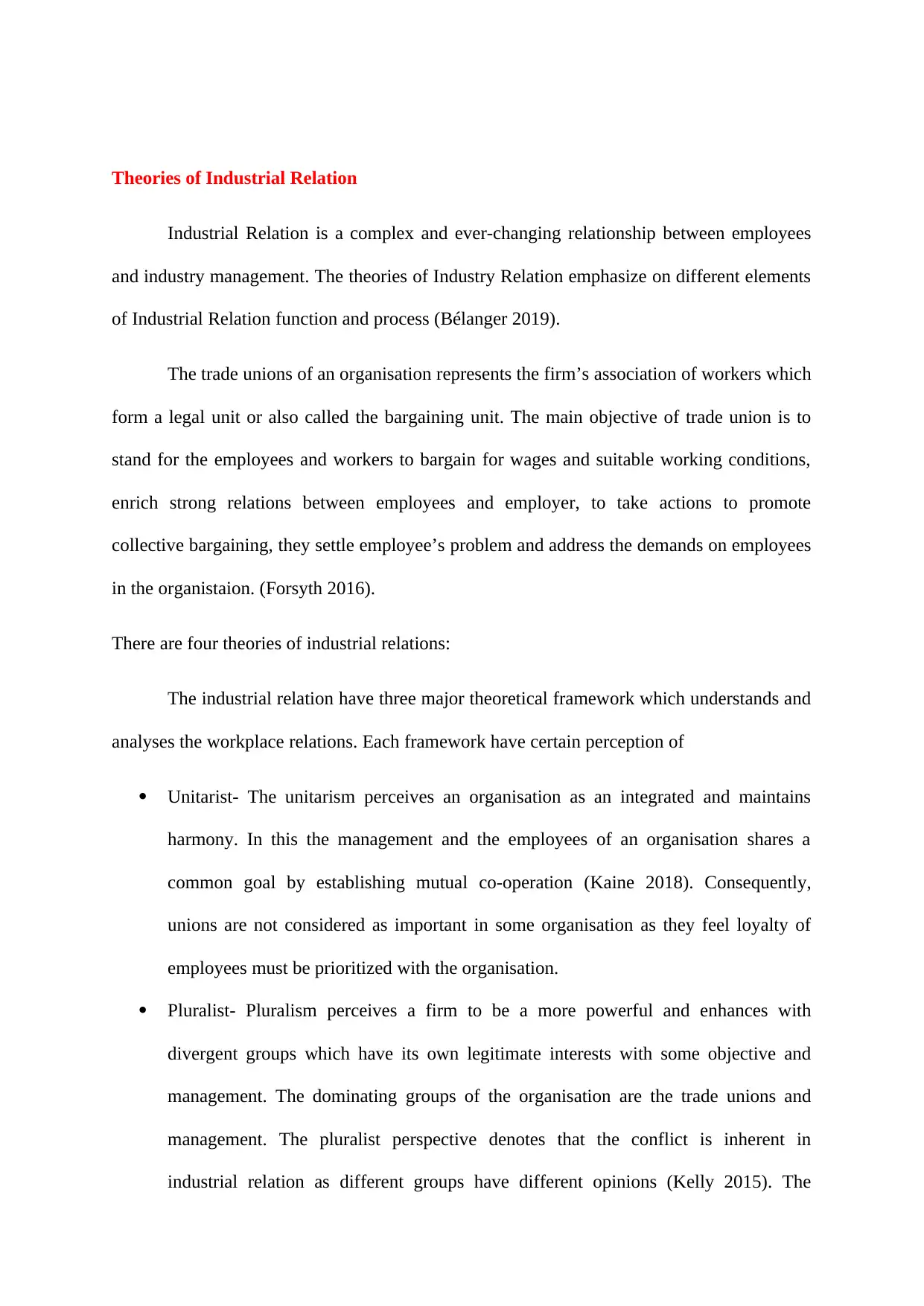
Theories of Industrial Relation
Industrial Relation is a complex and ever-changing relationship between employees
and industry management. The theories of Industry Relation emphasize on different elements
of Industrial Relation function and process (Bélanger 2019).
The trade unions of an organisation represents the firm’s association of workers which
form a legal unit or also called the bargaining unit. The main objective of trade union is to
stand for the employees and workers to bargain for wages and suitable working conditions,
enrich strong relations between employees and employer, to take actions to promote
collective bargaining, they settle employee’s problem and address the demands on employees
in the organistaion. (Forsyth 2016).
There are four theories of industrial relations:
The industrial relation have three major theoretical framework which understands and
analyses the workplace relations. Each framework have certain perception of
Unitarist- The unitarism perceives an organisation as an integrated and maintains
harmony. In this the management and the employees of an organisation shares a
common goal by establishing mutual co-operation (Kaine 2018). Consequently,
unions are not considered as important in some organisation as they feel loyalty of
employees must be prioritized with the organisation.
Pluralist- Pluralism perceives a firm to be a more powerful and enhances with
divergent groups which have its own legitimate interests with some objective and
management. The dominating groups of the organisation are the trade unions and
management. The pluralist perspective denotes that the conflict is inherent in
industrial relation as different groups have different opinions (Kelly 2015). The
Industrial Relation is a complex and ever-changing relationship between employees
and industry management. The theories of Industry Relation emphasize on different elements
of Industrial Relation function and process (Bélanger 2019).
The trade unions of an organisation represents the firm’s association of workers which
form a legal unit or also called the bargaining unit. The main objective of trade union is to
stand for the employees and workers to bargain for wages and suitable working conditions,
enrich strong relations between employees and employer, to take actions to promote
collective bargaining, they settle employee’s problem and address the demands on employees
in the organistaion. (Forsyth 2016).
There are four theories of industrial relations:
The industrial relation have three major theoretical framework which understands and
analyses the workplace relations. Each framework have certain perception of
Unitarist- The unitarism perceives an organisation as an integrated and maintains
harmony. In this the management and the employees of an organisation shares a
common goal by establishing mutual co-operation (Kaine 2018). Consequently,
unions are not considered as important in some organisation as they feel loyalty of
employees must be prioritized with the organisation.
Pluralist- Pluralism perceives a firm to be a more powerful and enhances with
divergent groups which have its own legitimate interests with some objective and
management. The dominating groups of the organisation are the trade unions and
management. The pluralist perspective denotes that the conflict is inherent in
industrial relation as different groups have different opinions (Kelly 2015). The
⊘ This is a preview!⊘
Do you want full access?
Subscribe today to unlock all pages.

Trusted by 1+ million students worldwide
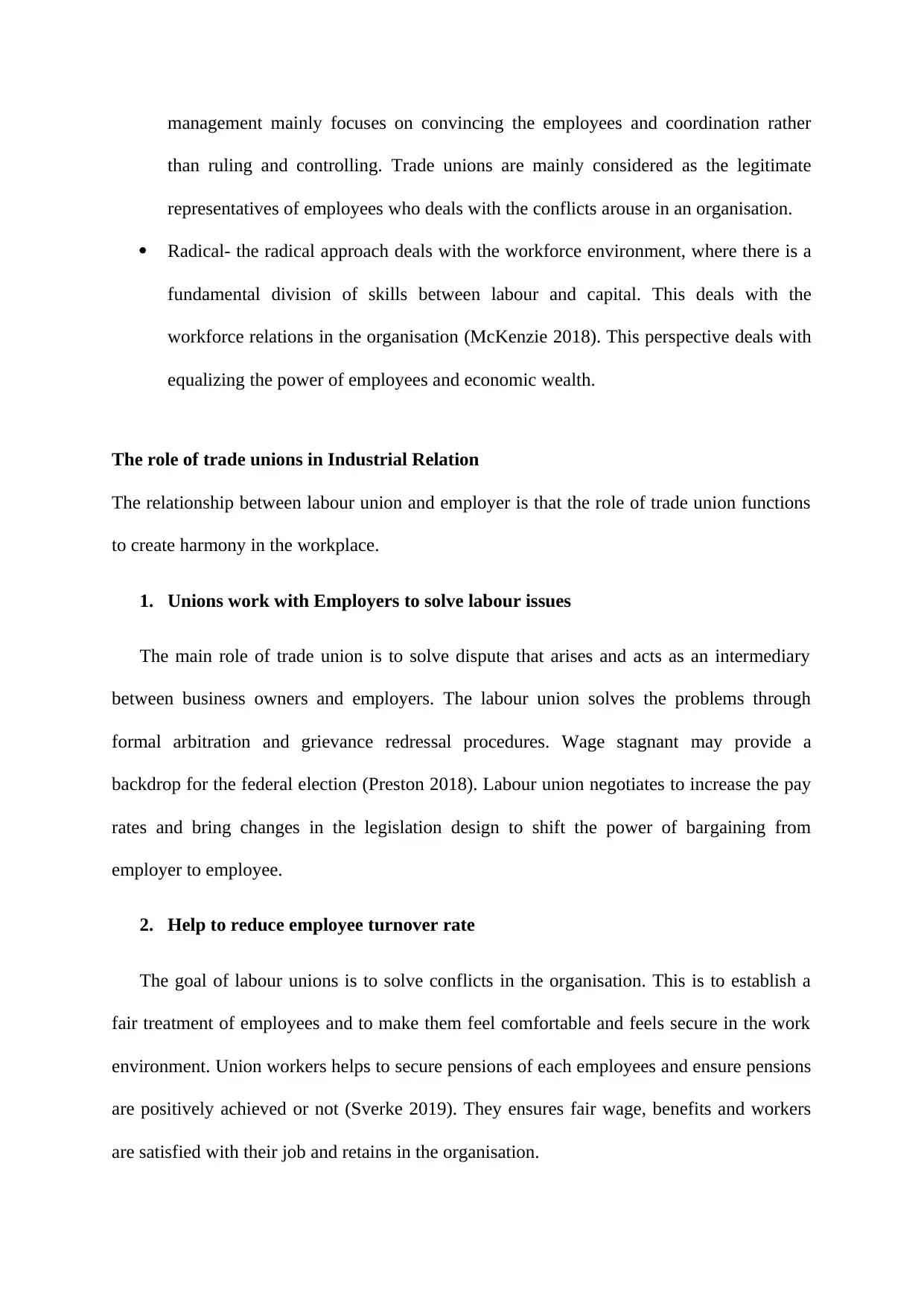
management mainly focuses on convincing the employees and coordination rather
than ruling and controlling. Trade unions are mainly considered as the legitimate
representatives of employees who deals with the conflicts arouse in an organisation.
Radical- the radical approach deals with the workforce environment, where there is a
fundamental division of skills between labour and capital. This deals with the
workforce relations in the organisation (McKenzie 2018). This perspective deals with
equalizing the power of employees and economic wealth.
The role of trade unions in Industrial Relation
The relationship between labour union and employer is that the role of trade union functions
to create harmony in the workplace.
1. Unions work with Employers to solve labour issues
The main role of trade union is to solve dispute that arises and acts as an intermediary
between business owners and employers. The labour union solves the problems through
formal arbitration and grievance redressal procedures. Wage stagnant may provide a
backdrop for the federal election (Preston 2018). Labour union negotiates to increase the pay
rates and bring changes in the legislation design to shift the power of bargaining from
employer to employee.
2. Help to reduce employee turnover rate
The goal of labour unions is to solve conflicts in the organisation. This is to establish a
fair treatment of employees and to make them feel comfortable and feels secure in the work
environment. Union workers helps to secure pensions of each employees and ensure pensions
are positively achieved or not (Sverke 2019). They ensures fair wage, benefits and workers
are satisfied with their job and retains in the organisation.
than ruling and controlling. Trade unions are mainly considered as the legitimate
representatives of employees who deals with the conflicts arouse in an organisation.
Radical- the radical approach deals with the workforce environment, where there is a
fundamental division of skills between labour and capital. This deals with the
workforce relations in the organisation (McKenzie 2018). This perspective deals with
equalizing the power of employees and economic wealth.
The role of trade unions in Industrial Relation
The relationship between labour union and employer is that the role of trade union functions
to create harmony in the workplace.
1. Unions work with Employers to solve labour issues
The main role of trade union is to solve dispute that arises and acts as an intermediary
between business owners and employers. The labour union solves the problems through
formal arbitration and grievance redressal procedures. Wage stagnant may provide a
backdrop for the federal election (Preston 2018). Labour union negotiates to increase the pay
rates and bring changes in the legislation design to shift the power of bargaining from
employer to employee.
2. Help to reduce employee turnover rate
The goal of labour unions is to solve conflicts in the organisation. This is to establish a
fair treatment of employees and to make them feel comfortable and feels secure in the work
environment. Union workers helps to secure pensions of each employees and ensure pensions
are positively achieved or not (Sverke 2019). They ensures fair wage, benefits and workers
are satisfied with their job and retains in the organisation.
Paraphrase This Document
Need a fresh take? Get an instant paraphrase of this document with our AI Paraphraser
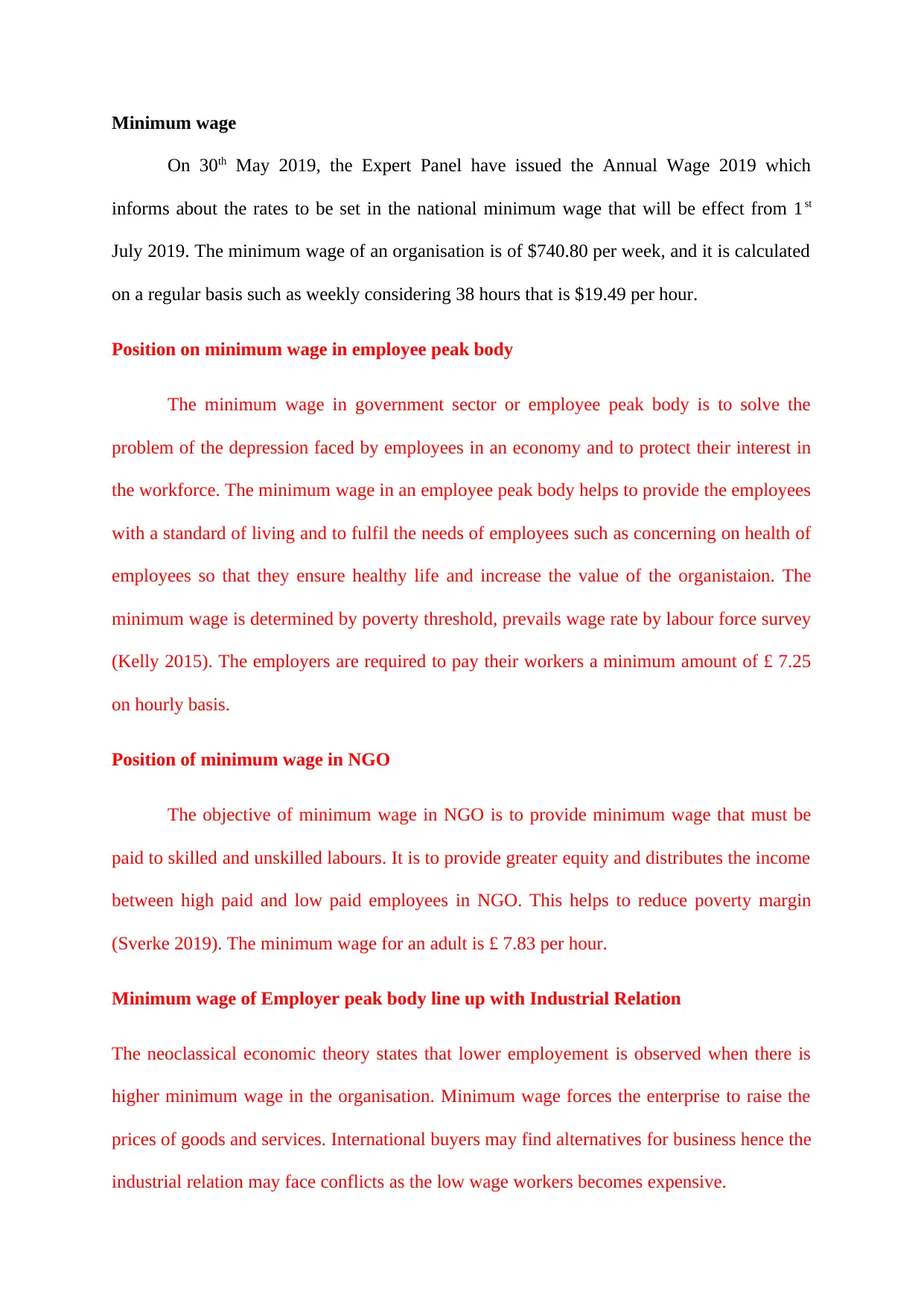
Minimum wage
On 30th May 2019, the Expert Panel have issued the Annual Wage 2019 which
informs about the rates to be set in the national minimum wage that will be effect from 1st
July 2019. The minimum wage of an organisation is of $740.80 per week, and it is calculated
on a regular basis such as weekly considering 38 hours that is $19.49 per hour.
Position on minimum wage in employee peak body
The minimum wage in government sector or employee peak body is to solve the
problem of the depression faced by employees in an economy and to protect their interest in
the workforce. The minimum wage in an employee peak body helps to provide the employees
with a standard of living and to fulfil the needs of employees such as concerning on health of
employees so that they ensure healthy life and increase the value of the organistaion. The
minimum wage is determined by poverty threshold, prevails wage rate by labour force survey
(Kelly 2015). The employers are required to pay their workers a minimum amount of £ 7.25
on hourly basis.
Position of minimum wage in NGO
The objective of minimum wage in NGO is to provide minimum wage that must be
paid to skilled and unskilled labours. It is to provide greater equity and distributes the income
between high paid and low paid employees in NGO. This helps to reduce poverty margin
(Sverke 2019). The minimum wage for an adult is £ 7.83 per hour.
Minimum wage of Employer peak body line up with Industrial Relation
The neoclassical economic theory states that lower employement is observed when there is
higher minimum wage in the organisation. Minimum wage forces the enterprise to raise the
prices of goods and services. International buyers may find alternatives for business hence the
industrial relation may face conflicts as the low wage workers becomes expensive.
On 30th May 2019, the Expert Panel have issued the Annual Wage 2019 which
informs about the rates to be set in the national minimum wage that will be effect from 1st
July 2019. The minimum wage of an organisation is of $740.80 per week, and it is calculated
on a regular basis such as weekly considering 38 hours that is $19.49 per hour.
Position on minimum wage in employee peak body
The minimum wage in government sector or employee peak body is to solve the
problem of the depression faced by employees in an economy and to protect their interest in
the workforce. The minimum wage in an employee peak body helps to provide the employees
with a standard of living and to fulfil the needs of employees such as concerning on health of
employees so that they ensure healthy life and increase the value of the organistaion. The
minimum wage is determined by poverty threshold, prevails wage rate by labour force survey
(Kelly 2015). The employers are required to pay their workers a minimum amount of £ 7.25
on hourly basis.
Position of minimum wage in NGO
The objective of minimum wage in NGO is to provide minimum wage that must be
paid to skilled and unskilled labours. It is to provide greater equity and distributes the income
between high paid and low paid employees in NGO. This helps to reduce poverty margin
(Sverke 2019). The minimum wage for an adult is £ 7.83 per hour.
Minimum wage of Employer peak body line up with Industrial Relation
The neoclassical economic theory states that lower employement is observed when there is
higher minimum wage in the organisation. Minimum wage forces the enterprise to raise the
prices of goods and services. International buyers may find alternatives for business hence the
industrial relation may face conflicts as the low wage workers becomes expensive.
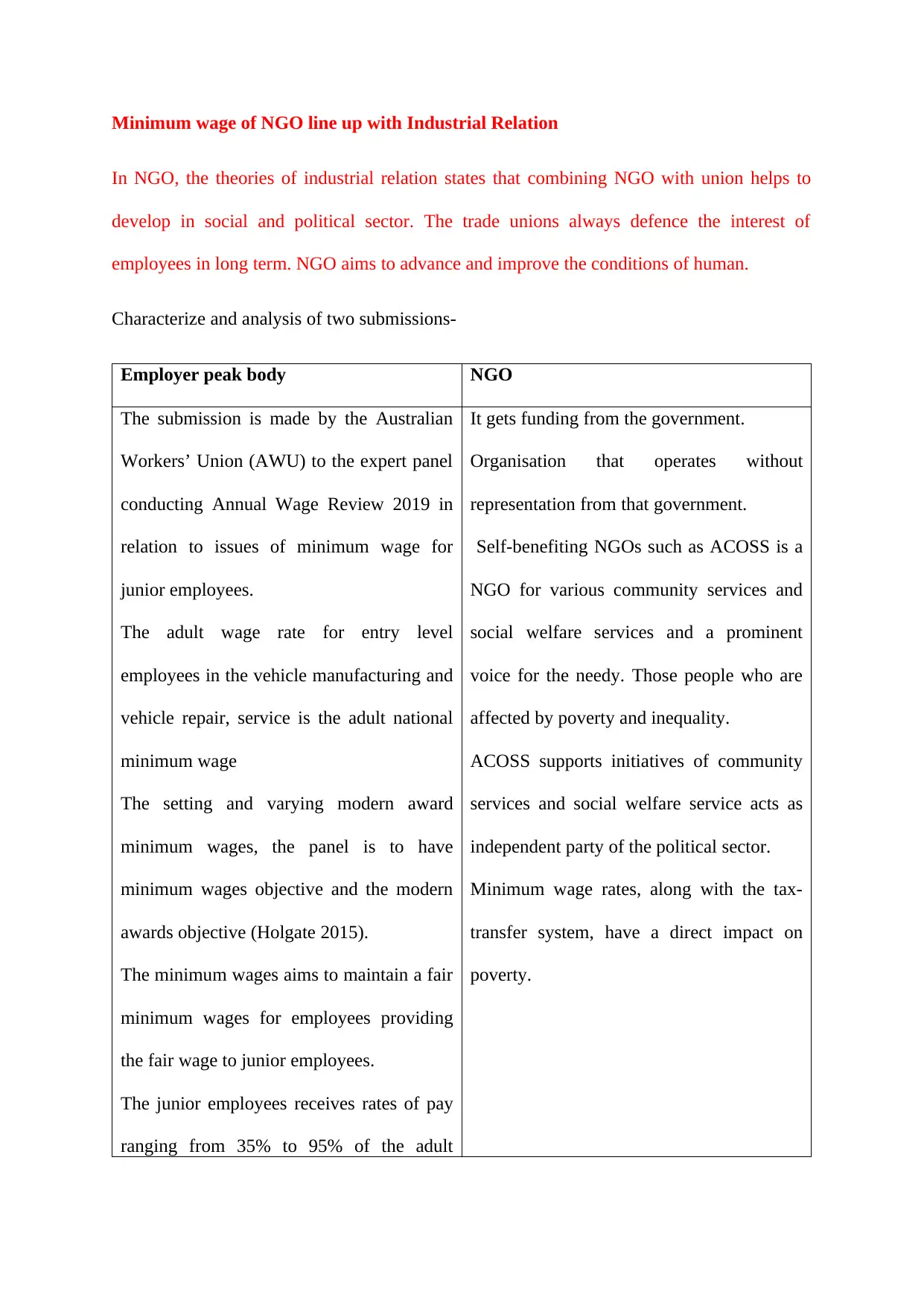
Minimum wage of NGO line up with Industrial Relation
In NGO, the theories of industrial relation states that combining NGO with union helps to
develop in social and political sector. The trade unions always defence the interest of
employees in long term. NGO aims to advance and improve the conditions of human.
Characterize and analysis of two submissions-
Employer peak body NGO
The submission is made by the Australian
Workers’ Union (AWU) to the expert panel
conducting Annual Wage Review 2019 in
relation to issues of minimum wage for
junior employees.
The adult wage rate for entry level
employees in the vehicle manufacturing and
vehicle repair, service is the adult national
minimum wage
The setting and varying modern award
minimum wages, the panel is to have
minimum wages objective and the modern
awards objective (Holgate 2015).
The minimum wages aims to maintain a fair
minimum wages for employees providing
the fair wage to junior employees.
The junior employees receives rates of pay
ranging from 35% to 95% of the adult
It gets funding from the government.
Organisation that operates without
representation from that government.
Self-benefiting NGOs such as ACOSS is a
NGO for various community services and
social welfare services and a prominent
voice for the needy. Those people who are
affected by poverty and inequality.
ACOSS supports initiatives of community
services and social welfare service acts as
independent party of the political sector.
Minimum wage rates, along with the tax-
transfer system, have a direct impact on
poverty.
In NGO, the theories of industrial relation states that combining NGO with union helps to
develop in social and political sector. The trade unions always defence the interest of
employees in long term. NGO aims to advance and improve the conditions of human.
Characterize and analysis of two submissions-
Employer peak body NGO
The submission is made by the Australian
Workers’ Union (AWU) to the expert panel
conducting Annual Wage Review 2019 in
relation to issues of minimum wage for
junior employees.
The adult wage rate for entry level
employees in the vehicle manufacturing and
vehicle repair, service is the adult national
minimum wage
The setting and varying modern award
minimum wages, the panel is to have
minimum wages objective and the modern
awards objective (Holgate 2015).
The minimum wages aims to maintain a fair
minimum wages for employees providing
the fair wage to junior employees.
The junior employees receives rates of pay
ranging from 35% to 95% of the adult
It gets funding from the government.
Organisation that operates without
representation from that government.
Self-benefiting NGOs such as ACOSS is a
NGO for various community services and
social welfare services and a prominent
voice for the needy. Those people who are
affected by poverty and inequality.
ACOSS supports initiatives of community
services and social welfare service acts as
independent party of the political sector.
Minimum wage rates, along with the tax-
transfer system, have a direct impact on
poverty.
⊘ This is a preview!⊘
Do you want full access?
Subscribe today to unlock all pages.

Trusted by 1+ million students worldwide
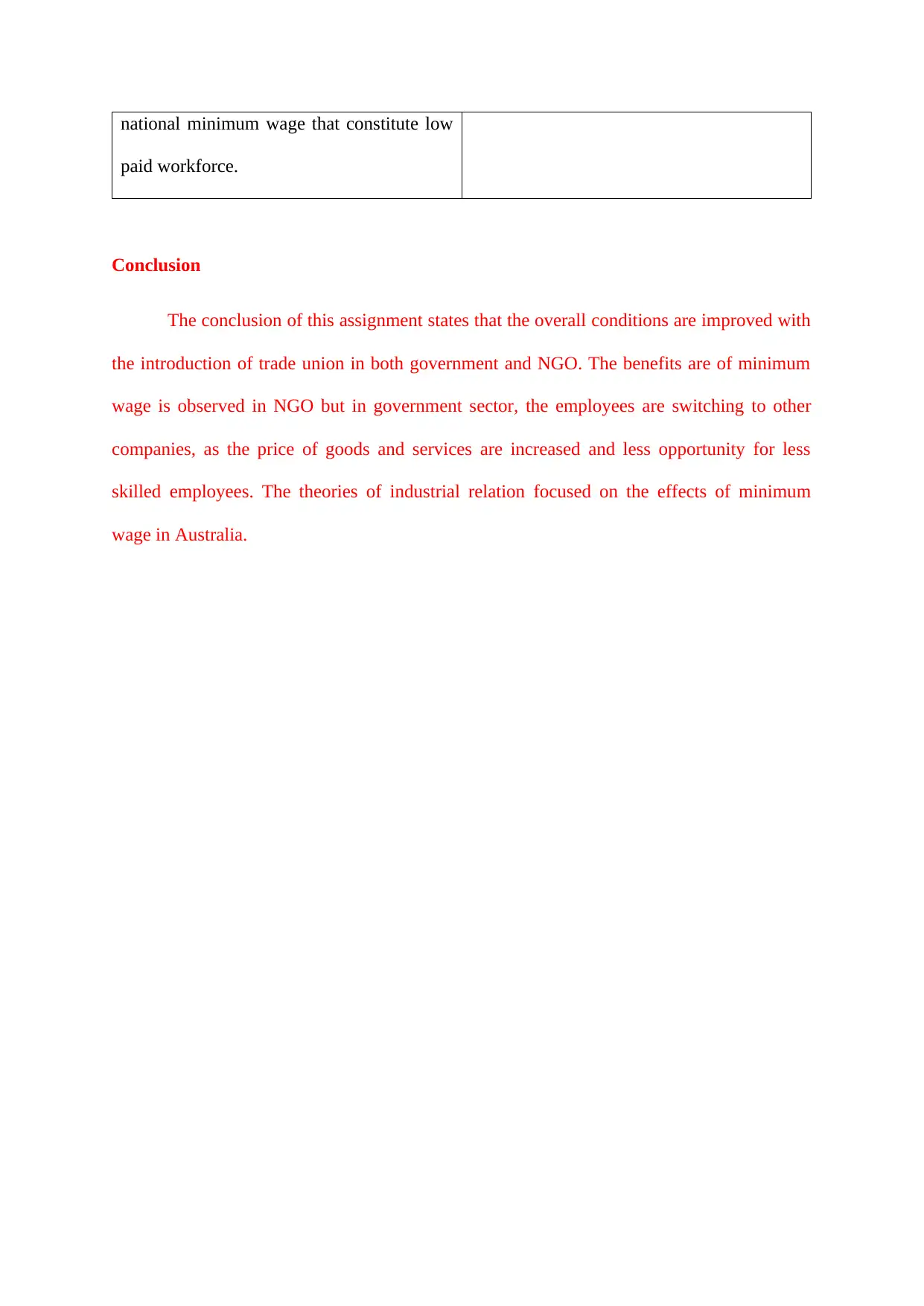
national minimum wage that constitute low
paid workforce.
Conclusion
The conclusion of this assignment states that the overall conditions are improved with
the introduction of trade union in both government and NGO. The benefits are of minimum
wage is observed in NGO but in government sector, the employees are switching to other
companies, as the price of goods and services are increased and less opportunity for less
skilled employees. The theories of industrial relation focused on the effects of minimum
wage in Australia.
paid workforce.
Conclusion
The conclusion of this assignment states that the overall conditions are improved with
the introduction of trade union in both government and NGO. The benefits are of minimum
wage is observed in NGO but in government sector, the employees are switching to other
companies, as the price of goods and services are increased and less opportunity for less
skilled employees. The theories of industrial relation focused on the effects of minimum
wage in Australia.
Paraphrase This Document
Need a fresh take? Get an instant paraphrase of this document with our AI Paraphraser
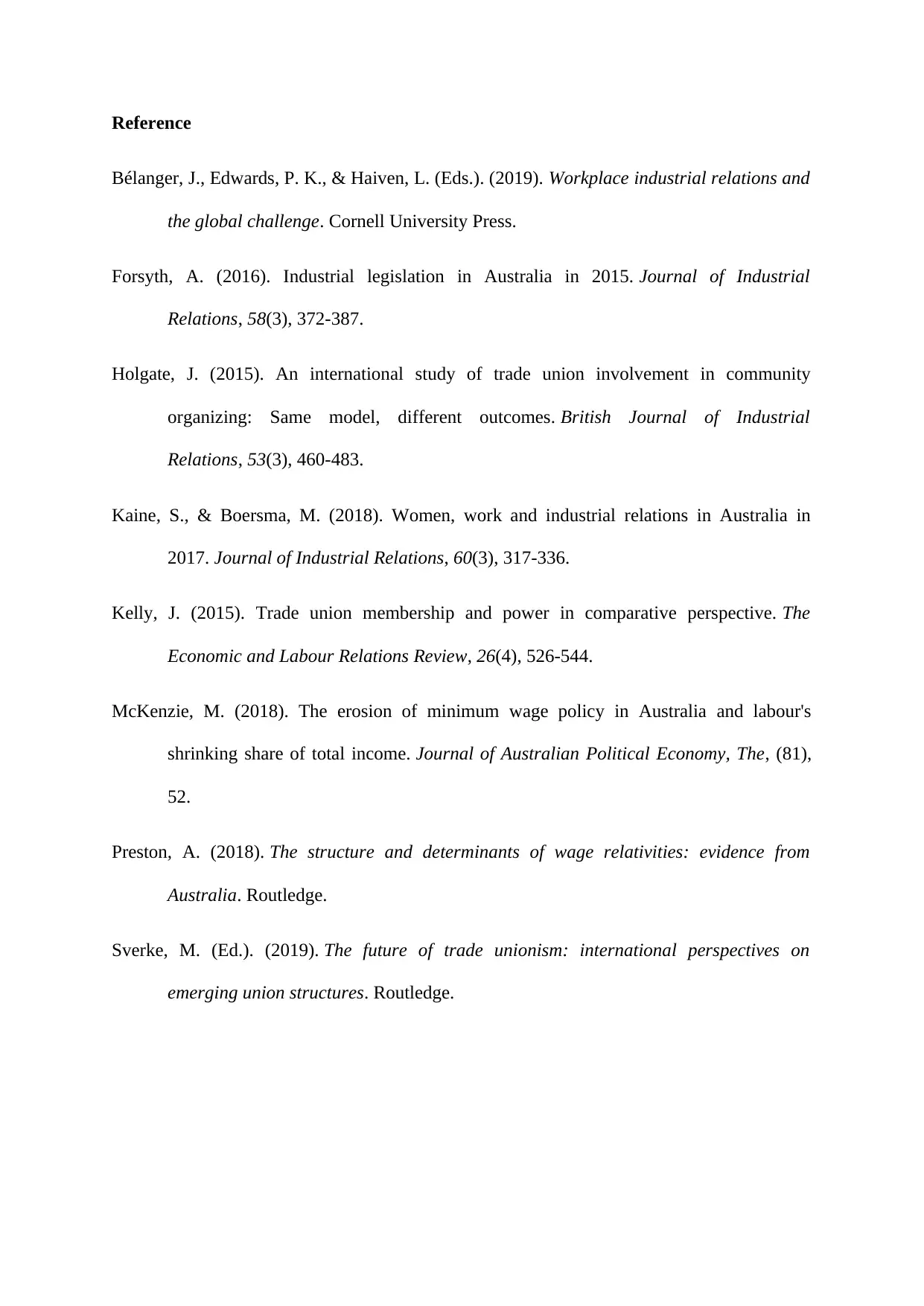
Reference
Bélanger, J., Edwards, P. K., & Haiven, L. (Eds.). (2019). Workplace industrial relations and
the global challenge. Cornell University Press.
Forsyth, A. (2016). Industrial legislation in Australia in 2015. Journal of Industrial
Relations, 58(3), 372-387.
Holgate, J. (2015). An international study of trade union involvement in community
organizing: Same model, different outcomes. British Journal of Industrial
Relations, 53(3), 460-483.
Kaine, S., & Boersma, M. (2018). Women, work and industrial relations in Australia in
2017. Journal of Industrial Relations, 60(3), 317-336.
Kelly, J. (2015). Trade union membership and power in comparative perspective. The
Economic and Labour Relations Review, 26(4), 526-544.
McKenzie, M. (2018). The erosion of minimum wage policy in Australia and labour's
shrinking share of total income. Journal of Australian Political Economy, The, (81),
52.
Preston, A. (2018). The structure and determinants of wage relativities: evidence from
Australia. Routledge.
Sverke, M. (Ed.). (2019). The future of trade unionism: international perspectives on
emerging union structures. Routledge.
Bélanger, J., Edwards, P. K., & Haiven, L. (Eds.). (2019). Workplace industrial relations and
the global challenge. Cornell University Press.
Forsyth, A. (2016). Industrial legislation in Australia in 2015. Journal of Industrial
Relations, 58(3), 372-387.
Holgate, J. (2015). An international study of trade union involvement in community
organizing: Same model, different outcomes. British Journal of Industrial
Relations, 53(3), 460-483.
Kaine, S., & Boersma, M. (2018). Women, work and industrial relations in Australia in
2017. Journal of Industrial Relations, 60(3), 317-336.
Kelly, J. (2015). Trade union membership and power in comparative perspective. The
Economic and Labour Relations Review, 26(4), 526-544.
McKenzie, M. (2018). The erosion of minimum wage policy in Australia and labour's
shrinking share of total income. Journal of Australian Political Economy, The, (81),
52.
Preston, A. (2018). The structure and determinants of wage relativities: evidence from
Australia. Routledge.
Sverke, M. (Ed.). (2019). The future of trade unionism: international perspectives on
emerging union structures. Routledge.
1 out of 8
Related Documents
Your All-in-One AI-Powered Toolkit for Academic Success.
+13062052269
info@desklib.com
Available 24*7 on WhatsApp / Email
![[object Object]](/_next/static/media/star-bottom.7253800d.svg)
Unlock your academic potential
Copyright © 2020–2025 A2Z Services. All Rights Reserved. Developed and managed by ZUCOL.





